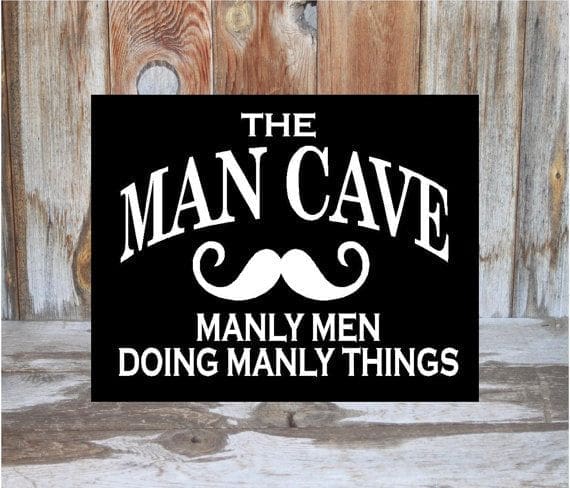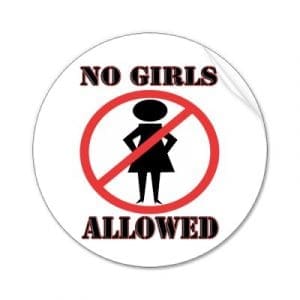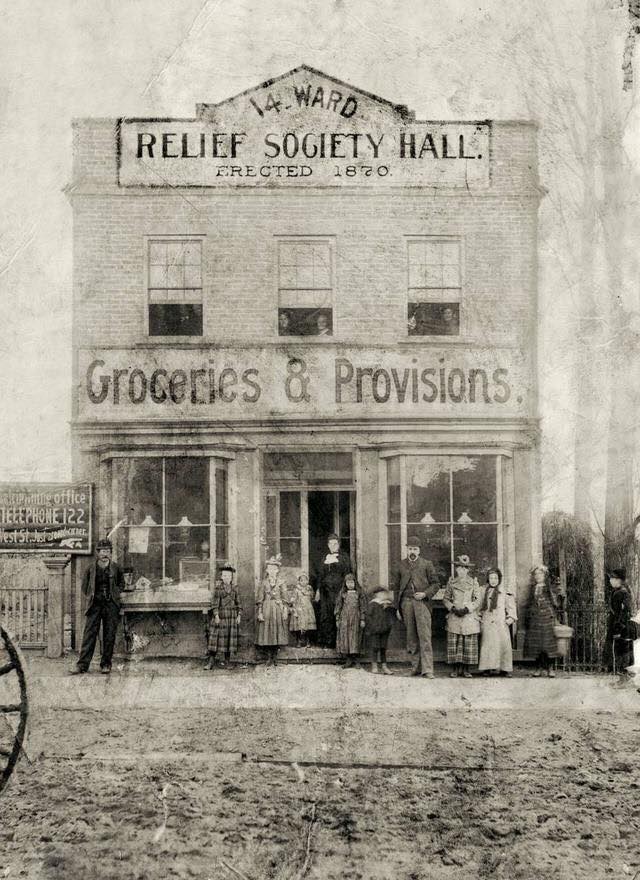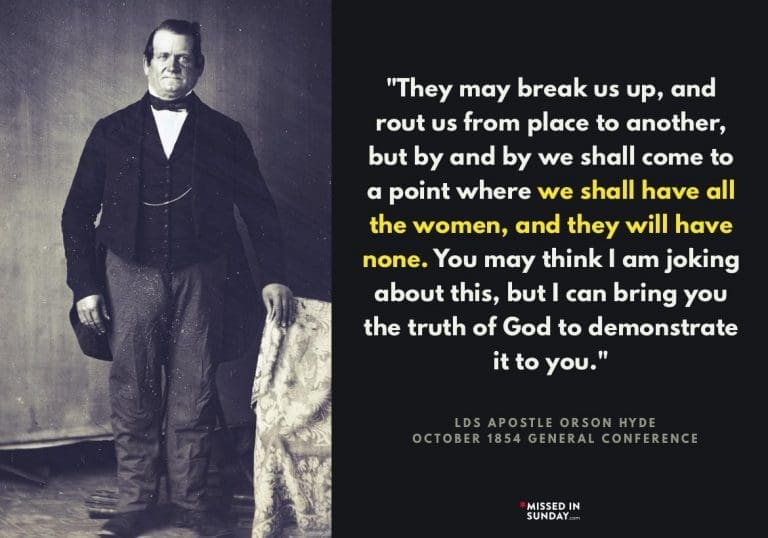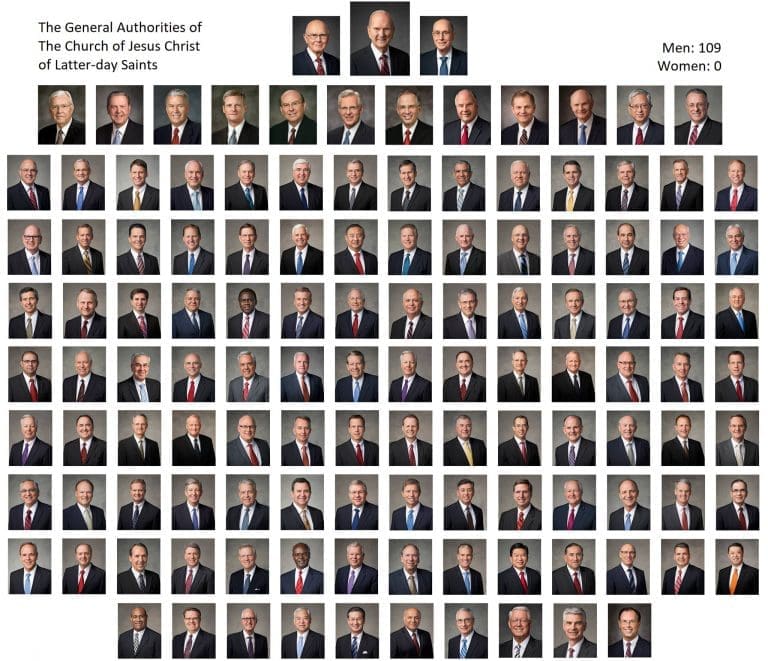To suggest that the role of women in Mormonism is complicated, would be an understatement. Joseph Smith’s early Church supported a very active female role, especially for the time period — even the performance of women’s priesthood healings in the temple for a brief time, before power consolidated into an increasingly pious and secretive male hierarchy. The ongoing doctrine of polygamy reinforced the notion that women are a form of property, enabling men to amass dynastic, eternal power as gods through temple ordinances. Smith accumulated up to 40 wives, while his successor Brigham Young expanded the practice and further glorified its doctrine, accumulating an estimated 55 wives. Elite Church leaders continued to illegally practice polygamy in secret for generations, but it is now officially discouraged as a living practice. Still, the place of women in the church remains contentious.
Numerous Prophets have instructed that a Mormon woman’s place is in the home. Only Federal anti-discrimination laws, which the Church vigorously opposed, and the threat of Federal prosecution, forced the Church in 1970s to stop terminating female employment upon the birth of her first child. While no longer as clearly directed from the pulpit, a women’s place in Mormonism remains very different than that of a man. Even into the 1980s, President Kimball reiterated that “…a mother’s place is in the home!” The idea of complementary spheres for men and women rules Mormon doctrine and is the answer to almost every question about the lack of power for women in the church.
Into the 1970s, the Mormon Relief Society was an independent organization that had its own magazine and its own fundraising power. Then correlation came along and the Relief Society was place under control of their local bishops. In some ways, it seems that as the rest of society has moved forward toward equality, the church has moved backward. Today, Mormon women cannot exercise authority within the Church or establish financial budgets without direct male supervision and approval.
There are exceptionally few female leaders or inspiring stories of women in Mormonism or Church history. The Book of Mormon cites only 6 females by name in over 500 pages; 3 taken directly from the Bible (Sarah, Eve, Mary), Lehi’s wife Sariah who complained regularly against her husband and is rebuked, Isabel the harlot, and Abish the Lamanite woman who helped Ammon the Nephite missionary. Zoram, Nephi, and his brothers all wed, yet each woman is clumsily identified as Ishmael’s daughter. Modern LDS women are presented an exclusively male gerontocracy leadership structure, in stark contrast to increasing opportunities in equality, education, employment and their personal lives. The only God presented in the Book of Mormon is also male, and though Mormons sometimes speculate on the idea of a Heavenly Mother, they are encouraged not to speak to her or pray to her and know little about her. During the active polygamous days of the Church, the thought surfaced that there were multiple heavenly mothers, all working to bring more children into the spirit world.
Because of the enforced paradigm of heterosexual marriage necessary for admission into the highest level of Mormon heaven, the Celestial Kingdom, single LDS women often feel excluded from their married counterparts. The Church has instructed members to date only temple-worthy partners within the Mormon religion, resulting in a disproportionately large population of single women who have bypassed strongly desired relationship, marriage and child-bearing opportunities in exchange for the promised blessings of motherhood and a temple worthy husband (likely a previously married one with at least one temple-sealed wife already) in the after-life. This, too, suggests that women have a lesser role in the Mormon vision of the world to come, not just fewer opportunities in this life to exercise their talents and capacities in the Church’s authority structure.
Though some Mormon women say that they feel equal, and that the power disparity does not bother them, the fact that the LDS Church continues to work hard to prevent the passage of the Equal Rights Amendment in Utah indicates a contrary scenario.
EXCLUSIVELY MEN
Perhaps there are reasons why Glass Ceiling ranks Utah 49th in the nation for gender pay equality, and why BYU boasts one of the lowest female faculty rates of any school, not to mention a near zero for the average salary of female graduates, who largely follow the admonitions to stay home with children and be nurturers while they assist their husband’s career ambitions from behind the scenes. Some may argue that the reasons for the abandonment of career opportunities are cultural and not doctrinal, but the end result is the same.
In the pre-1990 LDS temple ceremony, women were instructed to think of themselves as Eve in the Garden and are told, “Eve, because thou hast hearkened to the voice of Satan, and hast partaken of the forbidden fruit, and given unto Adam, I will greatly multiply thy sorrow and thy conception. In sorrow shalt thou bring forth children; nevertheless, thou mayest be preserved in childbearing. Thy desire shall be to thy husband, and he shall rule over thee in righteousness.” Thus, Mormon women are not saved merely by the grace of God, but through childbearing and their authority-holding husband. Only recently (since 2019) has the patriarchal rhetoric of the temple been softened so that women are not required to pledge obedience directly to their husbands, but now do so to God.
WOMEN NOT TO SPEAK OR PRAY
Another way in which women are excluded from visibility and authority within the Mormon Church can be seen in General Conference speaking assignments. Lucy Mack Smith, the Prophet’s mother, was the first woman to speak at General Conference Oct 8, 1845. LDS authorities did not invite another woman to address Conference for 143 years. In a 1967 Priesthood Bulletin, the First Presidency provided the following instructions: “Only those who bear the Priesthood [should] be invited to offer the opening and closing prayers in sacrament meetings, including fast meetings. This also applies to priesthood meetings.” The August 1975 Ensign reiterated this inspired policy.
Not until 1978 did the Church release a statement affirming that there was “no scriptural prohibition against sisters offering prayers in sacrament meetings….it was therefore decided that it is permissible for sisters to offer prayers in any meetings they attend.” [1] But it would not be until April 6, 2013 that Jean A. Stevens was invited by the Brethren to offer the very first female prayer at the worldwide opening conference session. Are women really equal to men in terms of offering spiritual guidance, even within their homes, if they are not seen as capable of praying before the entire church? And why is it that men always preside over and deliver keynote presentations at the women’s conference, explaining to women how to be better women, while women are never asked to speak to men about being better men?
NO VOICE OF INSTRUCTION
Though women are given positions of leadership worldwide (in the General Primary Presidency, General Relief Society Presidency and General Young Women’s Presidency – only over other women and children), they are often treated as “auxiliary” to the true leaders, the men. They are rarely even consulted over doctrinal or scriptural matters, and certainly not given any veto power.
In 2005, former 1st Counselor of the General Relief Society Presidency, Chieko N. Okazaki, granted an amazing interview to Gregory Prince in Dialogue: a Journal of Mormon Thought. When she realized that the lesson manual was due to be updated soon she prayerfully wrote a general outline to get the important process underway. After her outline was approved by the Relief Society Presidency, she brought it to the appropriate male-led Curriculum Committee. She was promptly informed that her lesson manual outline and suggestions were not necessary because a new manual was already nearing completion. Men, exercising their priesthood authority, wrote the instruction manuals without consulting women.
Okazaki also explained that the “Proclamation on the Family,” which was presented in the General Women’s Conference as newly minted quasi scripture, was never given to the women for consultation, much less approval. Clearly, the male priesthood leadership above them retains exclusive right to declare God’s will for the Church, as the women were provided the opportunity to stand next to them and smile. One wonders what the women might have changed in that controversial piece, and how certain problems might have been minimized if they’d had the chance.
LEARN MORE:
- Dialogue: There Is Always a Struggle
- Rational Faiths: Why Aren’t Women Included?
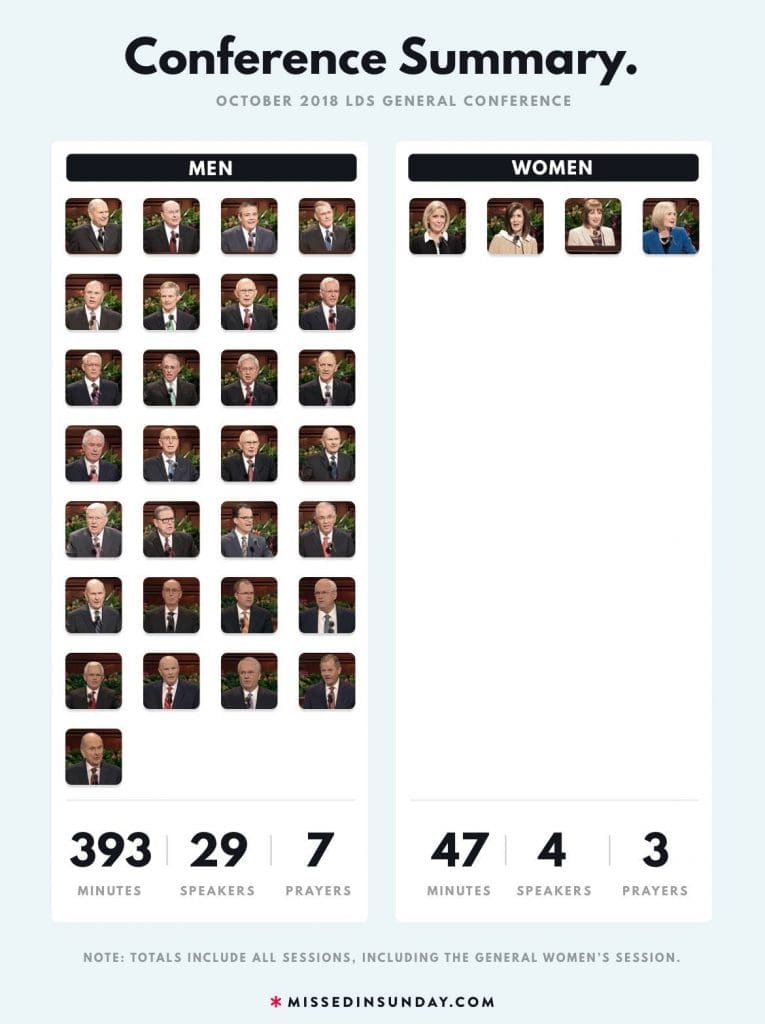
WOMEN AS ETERNAL PROPERTY
Many LDS women have expressed frustration with the secondary nature of their role within Mormonism. In addition to covenanting to obey their husbands (as he obeys God), leaving men as intermediaries between women and God, in the official LDS temple marriage ceremony, women “gave” themselves to their husband, while both men and women were to “receive” one another. Some argue that this language is purposely maintained to support possible polygamous marriages in heaven (men married to multiple women, though the reverse is not doctrinally possible). In any case, it is unequal; the covenants are different for a reason.
Furthermore, women still cannot access the highest level of LDS heaven without a husband to receive her through the veil. LDS Apostle Erastus Snow wrote more than a century ago, “Can you get into the celestial kingdom without him? Have any of you been there? You will remember that you never got into the celestial kingdom [during the temple ceremony] without the aid of your husband. If you did, it was because your husband was away, and some one had to act proxy for him. No woman will get into the celestial kingdom, except her husband receives her, if she is worthy to have a husband; and if not, somebody will receive her as a servant.” [2] It seems this doctrine has not really changed in the intervening years.
A woman’s highest degree of exaltation still depends upon her husband’s priesthood authority. Joseph Smith told the women of the Nauvoo Relief Society “May God add his blessing upon your heads and lead you in all the paths of virtue, piety & peace, that you may be an ornament unto those to whom you belong, and rise up and crown them with honors, ….” [3] Virtue, piety, and peace are values to keep women in their place in the patriarchy, which Joseph Smith was intent on maintaining once he’d introduced polygamy to the men of the Church.
Heber C. Kimball is credited with saying, “The brother missionaries have been in the habit of picking out the prettiest women for themselves before they get here, and bringing only the ugly ones for us. Hereafter you have to bring them all here before taking any of them, and let us all have a fair shake.” And he was certainly referring to women as property when he instructed, ”You are sent out as shepherds to gather the sheep together; and remember that they are not your sheep: they belong to Him that sends you. Then do not make a choice of any of those sheep; do not make selections before they are brought home and put into the fold. You understand that. Amen.” [4] The male leadership of the early Church appear to have taken seriously the matter of who was to have first pick of the prized “livestock.”
Apostle Orson Hyde elaborated upon the doctrine of accumulating women into the eternities. This is the Orson whom Joseph dispatched on a distant mission, discovering upon his return that Joseph had taken his civilly married wife, Marinda Nancy Johnson Hyde, as a plural bride in his absence. This is the very same Marinda that Joseph had pursued a decade prior, earning him a violent tar and feathering at the hands of her family members. [5]
But Hyde wrote, “In the spirit world there is an increase of males and females, there are millions of them, and if I am faithful all the time, and continue right along with brother Brigham, we will go to brother Joseph [Smith] and say, ‘Here we are brother Joseph’…. He will say to us,…. ‘Where are your wives?’ ‘They are back yonder; they would not follow us.’ ‘Never mind,’ says Joseph, ‘here are thousands, have all you want.’” [6] Though shocking in comparison, this does not sound all that different from promises of virgins for terrorist martyrs, and it certainly doesn’t sound like equality or respect between the sexes.
RELIEF SOCIETY
A brief examination of Joseph Smith’s actions further demonstrates how he set the tone for the treatment of females in the LDS Church. On March 17th, 1842 Joseph Smith sponsored the organization of the Relief Society, with Emma Smith as President. Her counselors were Elizabeth Ann Whitney, Sarah Cleveland, and Eliza R. Snow.
On June 29th, 1842, Joseph Smith took Sarah Cleveland as his 12th plural wife, who was at the time already married to John Cleveland, her second husband of fifteen years. On that same day, Smith married Eliza R Snow (Sarah Cleveland was a witness to this sealing). On July, 1842 Smith married Sarah Ann Whitney, Elizabeth’s daughter, with Elizabeth and Newell Whitney’s consent. Thus, within four months of establishing the Relief Society, all of Emma’s leaders were compromised by polygamy without her knowledge. Those same women were defending Joseph to Emma, suggesting that no-one should speak evil of the Prophet.
Building upon his momentum in acquiring ladies of the Society, Smith married Martha Knight as his 16th wife in August. According to the Church’s First Fifty Years of Relief Society, there were 19 participants in attendance at that first meeting of the heralded womens’ group, besides Emma herself. Within approximately 18 months, 5 of the 19 would become Smith’s polygamous wives (Desdemona Fulmer, Eliza R. Snow, Martha McBride Knight, Elvira Cowles, and Sarah M. Cleveland). Smith proposed to another 2 of the 19 but they rejected him (Nancy Rigdon and Sarah M. Kimball). He also proposed to John Taylor’s wife, Leonora, but when rebuffed, suggested it was only a test of her husband’s faith. John Taylor said yes, by the way.
LEARN MORE:
SHUT IT DOWN
Emma Smith had taken to using the Relief Society as a platform to oppose polygamy, so the meetings were suspended on March 16, 1844. Within months of assuming leadership, Brigham Young began marrying some of Smith’s wives as his own, and announced his decision to “stay” (dissolve) the organization. Eliza R. Snow, the originator of the first Charter and bylaws, took the group’s minutes and charter west with her to Utah.
In 1854, a group of sisters with limited means formed an “Indian Relief Society” to provide compassionate service to local Indians. The group remained informal and independent of any official Church recognition. To stave off a full blown resurrection of The Society, Young encouraged sisters to convene independent Indian relief societies at their ward levels without organizational support to sustaining them.
In 1868, Brigham Young asked Eliza R. Snow, then one of his plural wives, to reorganize the Church-wide Relief Society. Young’s action corresponded with the period of “retrenchment” – keeping LDS members to the fundamentals of the Church, including polygamy, in the face of the upcoming railroad incursion into Utah. Thus, the “Why it was dissolved” and “Why it was resumed” both had to do with polygamy.
NOT A WOMENS’ GROUP
As it is currently structured, the LDS Relief Society is unquestionably an auxiliary to the Priesthood, as women are not allowed to hold any presiding office. Every calling within the organization must be approved by a man at the Ward or Stake level, then the woman must be “set apart” exclusively by a group of men, with women sitting to the side.
The Relief Society is a group of women organized, budgeted and presided over by men. All leaders of this women’s group, from the General President on down to the President of the most remote branch, are selected by men in closed door meetings to which no women are invited. Men also oversee the instruction manuals of the women’s organization, and all activities must be approved by men. Women may not even hold an activity in a Church building without the supervision of a man. While women visitors are welcome, actual membership in the group is not open to the public; women must first join the religion to become official members with rights, responsibilities or callings.
In 1970, within months of the death of President David McKay, influenced by Harold B. Lee and Joseph Fielding Smith, the Church terminated the Relief Society magazine, canceled independent fundraising events, closed separate bank accounts and moved the funds into the general fund for church-wide use. [7] Now the once financially independent organization remains entirely dependent upon the patriarchy for funds.
The LDS Church has a history of excommunicating women who speak against the exclusively male leadership, including Kate Kelly, organizer of Ordain Women in 2014. Even when young women go on camps, as the young men do, they are required to be accompanied by male leaders to “protect” them, perhaps, or just to watch over them. Mormon women seem deemed incapable of dealing with problems on their own. It is odd that in a church where the youth are so severely kept apart from each other by gender, adult men are still required to spend time overnight with young teen girls not related to them, and to interview them privately about sexual matters.
STAY IN THE HOME
LDS patriarchy continues to link a woman’s value to her homemaking skills. As late as 1981, the prophet suggested, “Beguiling voices in the world cry out for alternative life-styles for women. They maintain that some women are better suited for careers than for marriage and motherhood… The seeds of divorce are often sewn and the problems of children begin when mother works outside the home.” President Kimball went further to endorse that “Being a wife and mother and having a family is…priority…more important than a college degree, a job, developing talents, or anything else!” [8]
Eldon Tanner said in the 1970s, “A woman will find greater satisfaction and joy and make a greater contribution by being a wise and worthy mother raising good children than she could make in any other vocation.” [9] Does that mean that women aren’t capable of higher thinking, or that perhaps God commands them to do less than men?
Perhaps the legacy of Brigham Young’s declaration that, “A woman, be she ever so smart, will never know more than a man who holds the priesthood” is why Utah consistently ranks very near the bottom of gender equality, physical and mental health, socio-economic and political empowerment measures. The state that once prided itself on its women being the first to vote now seems to encourage women to not take part in the political process other than voting. The rate of women in office in Utah is dismal, and telling.
Surely, LDS daughters deserve the same developmental and economic opportunities as men, yet Utah ranked 50th in gender equality. LDS publications, such as Mothers’ Employment Outside The Home and Eternal Marriage Student Manual, make a woman’s role clear. The Washington Post recently revealed survey results indicating that Utah is the second-most sexist state in America. This was not accomplished by accident. The LDS Church wants to keep women in the home because that keeps men in control of the church authority structure, the political structure of the state, and the financial structure of the home. Additionally, many women in Mormonism that find themselves trapped in abusive relationships, lacking any other means of economic support, are encouraged by their bishops to remain in their marriage.
WOMEN GAVE BLESSINGS
Priests and Priestesses are both distinct terms used in scripture, hinting that the two roles are equivalent counterparts in accessing the power of God. The practice of women laying on of hands for each other happened often in Joseph Smith’s time, yet few in the Church today remain aware of the fact that Emma performed washings, anointings and sealings in the temple rituals. Woman also performed laying on of hands outside of the temple, for sickness and childbirth well into the 1900s. Smith said “all that believe whether male or female” had promise of casting out devils and healing sick; and that “there could be no more sin in any female laying hands on the sick than in wetting the face with water.” But the promise of equal priesthood power was reigned in by a rigid patriarchy that keeps men on the stands and women in the benches with small children.
LEARN MORE:
- Sunstone, A Gift Given: A Gift Taken
- Wheat and Tares, Mormon Women giving Blessings
- LDS Living, Women Giving Blessings in the Early Days of the Church
- Gospel Tangents, Women, Healers in LDS Temples
- Ordain Women, Ordain Women Discussion 2
- Female Ritual Healing in Mormonism, Jonathan Stapley and Kristine Wright
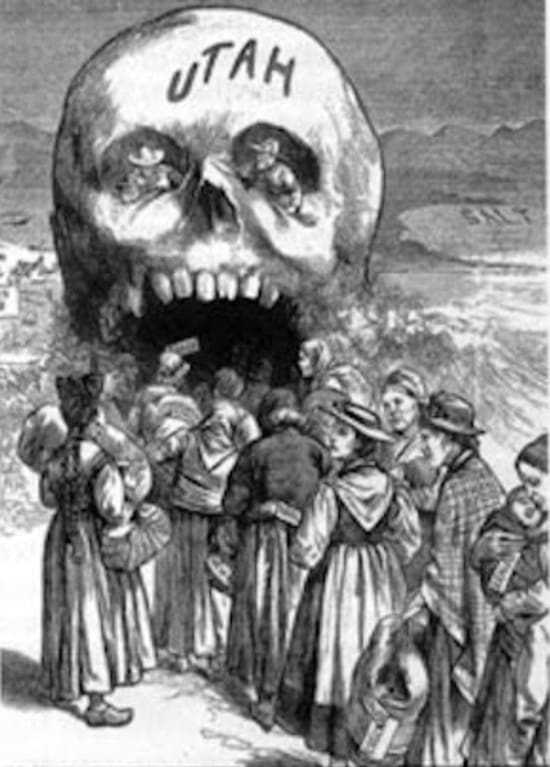
The patriarchy of the LDS Church was also sustained through the insistence that women could not go through the temple ceremony without a husband. In the 1930s, LDS bishops were instructed, “You will not give a recommend, under any circumstances, to a wife whose husband is not a member of the Church.” [10]
In 1970, the First Presidency declared that a woman married to an inactive man would henceforth be prevented from entering the temple, “even though the husband is willing to give his consent in writing for his wife to receive her endowment.” When Church leaders reaffirmed this policy in the 1976 General Handbook of Instructions, they noted that the same restriction did not apply to husbands; it seems because men do not need women in the way that women need men. In 1986 the First Presidency finally reversed its policy prohibiting women from attending the temple if they were married to non-Mormons. [11]
On 1973, Spencer Kimball, when asked “Will there be a change in attitude toward women?” replied “Not too abruptly. We believe that the ideal place for a woman is in the home.” [12] Given the geriatric leadership structure of the Church, it is perhaps understandable that attitudes toward women remain a generation or two behind the times.
Even into the mid 1970s, only single women worked at Church headquarters. If a women married, it was assumed her career would end so she could stay home. There was even an established LDS employment policy that termination would occur upon birth of a woman’s first child. The Church sought the legal opinions of three separate law firms before conceding that it could no longer terminate the career of first-time mothers. [13]
The Equal Rights Amendment of 1972, which formalized women’s rights, passed in both houses of Congress and simply awaited state ratification. The Church vigorously opposed it and formally organized members against it, playing a decisive role in its ultimate defeat. The Church excommunicated outspoken ERA advocate Sonia Johnson, suggesting “moral” objections while continuing to rally LDS women to champion political activities that supported the Church’s patriarchal power structure.
When screening the first cut of The First Vision video on April 19, 1976, Thomas Monson asked “Why did you feature the mother? We’ve got to feature the father. This is a priesthood-oriented Church. We’ve got to feature the priesthood, not the mother.” [14] The entire structure of the Church demands men, not women. For example, if 500 women were members, they could never form a ward. But 50 men, without a single woman, could easily staff all the vital and necessary positions.
LEARN MORE
- Nauvoo Relief Society Minute Book
- An Overlooked History of Mormon Relief Society
- Remembering the Wives of Joseph Smith
[1] Ensign, Nov. 1978.
[2] Journal of Discourses, LDS Apostle Erastus Snow, vol. 5, p. 291.
[3] Nauvoo Relief Society Minute Book, 88, josephsmithpapers.org.
[4] Journal of Discourses 6:256.
[5] Apostle Orson Hyde, LDS General Conference, Oct 1854.
[6] Apostle Heber C. Kimball, Journal of Discourses, vol 4, 209.
[7] Leonard Arrington; Writing of Mormon History, 233.
[8] The Honored Place of Women, LDS General Conference, Oct 1981.
[9] Eldon Tanner
[10] The Development of LDS Temple Worship p. xlviii.
[11] The Development of LDS Temple Worship, p. xlix.
[12] Leonard Arrington; Writing of Mormon History, 234.
[13] Leonard Arrington; Writing of Mormon History, 243.
[14] Leonard Arrington; Writing of Mormon History.

